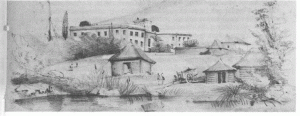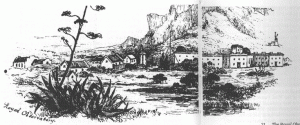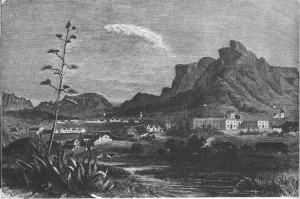Royal Observatory at the Cape of Good Hope
|
| Return to Cape Observatory main page. Return to Cape Observatory historical page. .Photo Gallery: Establishing the Observatory Planning the Observatory Early Years World Class Establishment Layout |
 A Camera Lucida drawing of the Cape Observatory by Sir John Herschel, January 2, 1837. The time ball was newly installed. To the right of the main building the Settler hut has been replaced by stables. On the banks of the river are another stable (originally Captain Ronald’s) and to its right a wooden workshop with thatched roof. Maclear added a fence around the main building to keep cattle from damaging the main building. Original in the possession of the South African Library.
A Camera Lucida drawing of the Cape Observatory by Sir John Herschel, January 2, 1837. The time ball was newly installed. To the right of the main building the Settler hut has been replaced by stables. On the banks of the river are another stable (originally Captain Ronald’s) and to its right a wooden workshop with thatched roof. Maclear added a fence around the main building to keep cattle from damaging the main building. Original in the possession of the South African Library.
Source: Warner – Maclear; Warner – Astronomers
 Sketch by an unknown artist, contained in the scrapbook of Charles Midgley. This shows approximately the same view as the previous photo, but with much more vegetation. In 1836 Piazzi Smyth had a windmill of his own design installed and started to plant trees. Original in the possession of the South African Library.
Sketch by an unknown artist, contained in the scrapbook of Charles Midgley. This shows approximately the same view as the previous photo, but with much more vegetation. In 1836 Piazzi Smyth had a windmill of his own design installed and started to plant trees. Original in the possession of the South African Library.
Source: Warner – Astronomers
 Henderson’s “Dismal Swamp” in as it appeared in 1911. The same view as the previous two photos but with much more vegetation. Original in the possession of the Africana Museum, Johannesburg.
Henderson’s “Dismal Swamp” in as it appeared in 1911. The same view as the previous two photos but with much more vegetation. Original in the possession of the Africana Museum, Johannesburg.
Source: Moore
 In 1841 the Magnetic Observatory was established, which substantially altered the appearance of the Observatory on its southern side. A cottage was build, a dwelling house for the staff and several smaller huts. A “Wind Tower” (to the left of the main building) supporting an anemometer. This structure was a copy of the Tower of Winds in Athens and was considered very picturesque and appropriate to the Grecian style of the main building. The main laboratory housing the Magnetic instruments was a structure of wood with copper and brass fittings (second building to the left of the Wind Tower). The laboratory was consumed by fire on 12 March 1852 and was replaced by a smaller one in 1859. Lithograph by C.F. Angas. From “The Colonies and India, 1877.”
In 1841 the Magnetic Observatory was established, which substantially altered the appearance of the Observatory on its southern side. A cottage was build, a dwelling house for the staff and several smaller huts. A “Wind Tower” (to the left of the main building) supporting an anemometer. This structure was a copy of the Tower of Winds in Athens and was considered very picturesque and appropriate to the Grecian style of the main building. The main laboratory housing the Magnetic instruments was a structure of wood with copper and brass fittings (second building to the left of the Wind Tower). The laboratory was consumed by fire on 12 March 1852 and was replaced by a smaller one in 1859. Lithograph by C.F. Angas. From “The Colonies and India, 1877.”
Source: Warner – Astronomers

The Observatory in 1865. The Sisal plant must have been very picturesque to inspire two sketches (look previous photo) from the same spot. Note the new Laboratory building replacing the burned down structure. Original in the possession of the Africana Museum.
Source: Moore
